|
Paper 27
The Dance Collections of William Campbell
Contributed by Paul Cooper, Research Editor
[Published - 19th March 2017, Last Changed - 10th September 2024]
William Campbell was a London based composer and publisher of dance publications, probably of Scottish descent. He was active over a roughly 35 year period spanning the end of the 18th and the start of the 19th centuries. His publications were of an unusually high quality; in this paper we'll investigate his works, his associates, and his influence over London's social dancing of the period.

Figure 1. Campbell's Trade Card (possibly). Courtesy of the British Museum.
Campbell's Career
Reliable biographical details for Campbell are scarce; he began publishing from around 1778, was active through to about 1815, and moved address at least 6 times. He printed collections on behalf of several dancing masters and went on to publish his own premium collections of dances from around 1786. Doane's 1794 Musical Directory lists him as being a player of the Viola and Violoncello, it also indicates that he had played in the grand performances at Westminster Abbey.
He moved address within London on numerous occasions. He was at 93 Berwick Street, Soho c.1778 to c.1782; 11, New Street, Covent Garden c.1782 to c.1793; 8, Dean Street, Soho c.1793 to c.1803; 4, Market Row, East Street, St. James's Market c.1803 to 1809; 37, New Compton Street, Soho c.1809 to c.1810; 31, King Street, Soho c.1810 to c.1814; 32 Dean Street, Soho, c.1815. These dates are estimates constructed from the pattern of addresses printed on his publications at their probable publication dates. For a brief period c.1795-1796 Campbell also promoted the business of Thomas Dodd (Musical Instrument Maker) at his vacated Covent Garden address on the covers of his publications, perhaps Dodd was a former employee who went on to run his own business.
He printed occasional dance collections on behalf of John Gow, C. Feuillade and Nicholas Lemaire (see Figure 2), his most consistent and lasting collaboration however was with Francis Werner. Werner published annual collections of Cotillions, Country Dances and Minuets through Campbell between about 1778 and 1785, these collections were of a high quality, they were amongst the best that were being sold in London. Werner died either in late 1785 or in 1786 (Morning Chronicle, 5th June 1786) thereby ending their collaboration. Werner's immediate successor was his assistant Martin Platts, Platts went on to publish through the much larger firm of Longman and Broderip rather than through Campbell. Campbell would have found himself without a premium annual collection to sell from this 1785 date. This may have been the trigger Campbell needed to launch his own series of premium dance collections. Campbell's new series of annual publications was issued from around 1786 through to around 1812, we'll study them shortly.
Note: John Fentum, a rival publisher, attempted to continue Werner's collection posthumously from his own musical warehouse from 1787. Fentum began his series of publications at number XIX, one after the final Werner publication, he indicated that he intends continuing this work in the same manner as the late Francis Werner . Fentum ceased referencing Werner on the covers of his publications in the early 1790s. Campbell must have had some form of professional collaboration with Fentum, the final plate of Campbell's c.1804 Book 19 indicates that it was engraved by J Fentum. It's possible that Fentum's business engraved the plates for all of Campbell's publications, at least until Fentum's death in 1806.
Campbell, like many other dance publishers in London at the time, printed two different series of dance collections. There was a cheap annual series of Twenty-Four Country Dances For The Year .... which ran between at least 1782 and 1798, also a premium collection aimed at the more discerning customers. The cheap format consisted of 24 country dances with a treble-score printed two dances per-page in oblong octavo format, they cost 6 pence per book. The premium publications were printed in quarto, each tune having both a treble and bass score; the tunes were of variable length and the books cost 2 shillings and 6 pence each. It's this premium collection that I find to be of most interest.
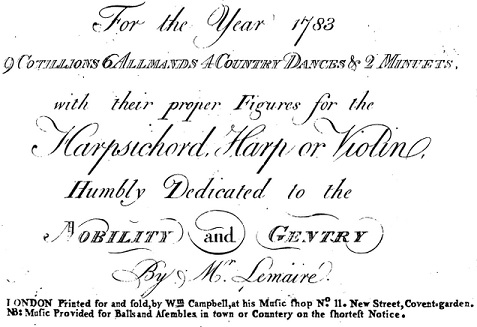
Figure 2. A publication by Mr Lemaire, 1783, printed and sold by Campbell.
Campbell issued what may have been intended as the first of a further series c.1808 (date uncertain), it was partially composed by Miss Weippert, and was titled No. 1 of Campbell's new and favorite original dances, strathspeys, reels &c. I'm not aware of any further editions having been published after this initial offering.
At some point Campbell's business was wound up, his publishing plates found their way into the possession of one of London's more successful music publishers, Robert Birchall. Campbell reprinted his premium collections on several occasions (perhaps to update the publication address on their covers), and Birchall did so too c.1815. Birchall died in 1819 (Public Ledger and Daily Advertiser, 21st December 1819), it's likely that this marked the end of Campbell's career, if indeed he was still living at that date. Many surviving editions of Campbell's collections date to these later reprints, the covers of some indicate that they were printed by Birchall. The fact that these collections were reprinted, or at least had their covers updated, is a hint to their success and popularity; presumably there was a market for the older collections many years after their initial publication. For example, the copy of Book 1 in Figure 3 is clearly not as first produced, it advertises the first 9 volumes of the collection on the cover; Campbell probably redesigned the cover when he changed address c.1793. Campbell and Birchall may have been partners at an earlier date; an advertisement for Campbell's 16th Collection published in 1801 (Morning Chronicle, 18th June 1801) describes the book as being Printed and sold by W. Campbell, No. 8, Dean Street, Soho; and at Mr. Birchall's Musical Circulating Library, No. 133, New Bond-street .
Campbell's description of his own occupation changed over time. Figure 2 shows a 1783 Campbell publication for Nicholas Lemaire, available at Campbell's Music Shop; a footnote adds of Campbell: Music Provided for Balls and Asembles in town or Countery on the shortest Notice . Campbell's 1799 insurance records record his occupation as music seller ; the cover of the c.1810 Book 25 describe his occupation as Musician , and an 1810 newspaper advertisement offering a piano for sale describes him as a Teacher of Music (Morning Post, 27th August 1810). Some of his later publications included the footnote Music Provided for Balls, Assemblies, &c in Town or Country, on Due Notice . The 1810 sale of his piano at ten guineas under the original price , may coincide with the pending closure of the business and transfer of assets to Birchall; I've struggled to find any information about him after that date. At least one further publication was issued under his name, Campbells Favorite Set of Country Dances & Strathspey Reels &c, for the Year 1815; there's no hint that this was published through Birchall, so the transfer of his assets may have been shortly thereafter.
Dating Campbell's Collections
Campbell didn't provide publication dates for most of his premium dance collections. It can be difficult to determine accurate dates for undated works, especially those that were reprinted several times; access to the nearly complete collection has enabled a plausible chronology to be established.
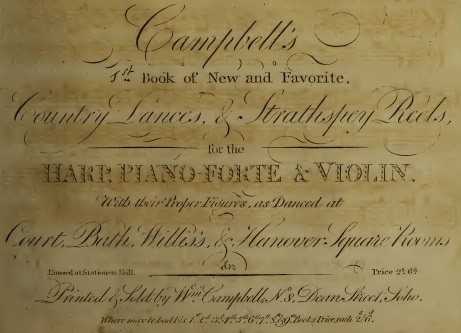
Figure 3. Reprint of Campbell's c.1786 1st Book
The only volume I've studied to carry an explicit date is Book 13, the year 1798 is printed on the cover. Any publication that claims to be for the year 1798 might perhaps have been published towards the end of the preceeding year, but it's sufficiently accurate for most purposes. The content of that collection includes tunes which are clearly named in reference to the 1797 Battle of Camperdown; such titles include Lord Duncans Victory, Sir Henry Trollope's Fancy, The Royal Artillery Whim or the 11th October and The Venerable. A collection featuring such tunes couldn't have been produced prior to the end of 1797, and would be out of date if printed later than 1798. The 1798 date for Book 13 seems secure.
The other firmly established dates involve Book 10 and Book 16. Book 10, unlike the other volumes in the collection, was registered for copyright purposes at Stationer's Hall, on the 31st October 1795. A copy of Book 9 was also registered on the same day. We might infer from this that the 10th book was published in 1795, and a copy of the slightly older 9th book was taken along from stock. One of the tunes is named The Royal Wedding, presumably in reference to the 1795 marriage of the then Prince George to Caroline of Brunswick. Campbell published an advert mentioning the 16th Book as New Music in the Morning Chronicle, 18th June 1801.
If we were to plot a graph of publication numbers over time, and draw a straight line between the 10th book in 1795, the 13th book in 1798, and the 16th in 1801, it offers the satisfying prospect of one publication per year. This starts c.1786 with Book 1, and places Book 25 as being published c.1810. These estimated dates are not established fact, but they do match tune names to historical events in a neat fashion. For example, the c.1806 Book 21 contains numerous references to the 1805 Battle of Trafalgar; the c.1810 Book 25 references the 1809 Battle of Talavera; the c.1800 Book 15 references the Duke of Rutland's birthday party, he turned 21 in 1799 and could have enjoyed a significant celebration; the c.1788 Book 3 may reference General Elliot being appointed Governor of Gibraltar in 1787. The starting date of c.1786 also fits neatly with the final publication date of Francis Werner's collections (which were published through Campbell) in 1785, suggesting that the end of one series coincided with the start of the successor series. A further clue can be found in a 1787 publication called Nina, the back of which lists the New Music available through George Goulding; the catalogue includes Campbell's Collections of Reels, Strathspeys, and Country Dances, with Figures, Two Books , presumably the first two of Campbell's collection dated c.1786 and c.1787. Such ties provide confidence that the chronology is probably accurate to within a year.
Campbell also published collections of Twenty Four Country Dances for the Year .... between at least 1782 and 1798. These collections show surprisingly little content overlap with the premium collections and are of unremarkable quality. The collection for 1790 has a few tunes in common with the c.1788 Book 3 and the c.1789 Book 4, and the collection for 1792 has several tunes in common with the c.1790 Book 5, little other overlap can be discerned in the collections I've studied.
Unusual Dances in Campbell's Collections
A distinguishing characteristic of Campbell's collections is the occasional inclusion of dances other than the simple Country Dance. Such exotica mark his collections as being more than a strictly formulaic collection of Country Dances.
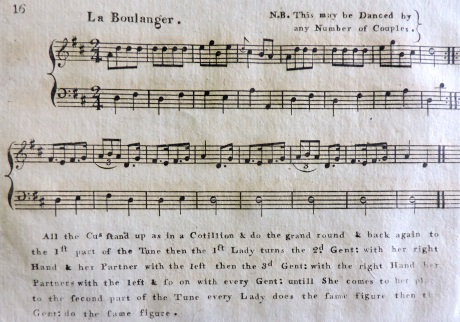
Figure 4. Campbell's La Boulanger from his c.1789 4th Book
The c.1788 Book 3 includes a Cotillion called La Pastorale. We've animated an arrangement of the version Longman & Broderip published in their 1786 Book the VI, Twenty Four New Cotillions. It was said to be a popular Cotillion amongst the dancers at Bath. Campbell's version is almost identical to that of Longman (the bass line differs), so he wasn't the first to publish this dance; whether he did so with permission is unclear. Longman's collection is of particular interest as it records prototypical versions of most of the Quadrilles of the First Set, but arranged as Cotillions. Campbell's inclusion of La Pastorale suggests that it was a popular Cotillion, or was in the process of becoming so in London.
The c.1789 Book 4 features a circular dance named La Boulanger (see Figure 4) arranged for any number of couples. This dance will be well known to Jane Austen enthusiasts as it was mentioned in Pride and Prejudice and also in one of Austen's 1796 letters to her sister Cassandra. Campbell's version of this dance is one of the first to have been published in Britain, though an earlier arrangement can be found in Francis Werner's 1780 13th Book (a book that was published through Campbell). This dance was often used to close Balls in Regency Britain. For example, Lady Sarah de Crespigny's masked ball in 1814 featured the boulanger, at a quarter past five (in the morning) to close the proceedings (Morning Post, 15th January 1814); it was reported of an Assembly at Chapel Field House in 1821 that It was three o'clock in the morning ere the music ceased, and the company withdrew , it ended with Sir Roger de Coverley and Le Boulanger (Norfolk Chronicle, 22nd December 1821); the dancing master Mr McKorkell closed his 1805 Pupils' Ball with La Boulangere (an alternative spelling of the same dance, Northampton Mercury, 16th November 1805). A Ball at the Royal Pavilion in Brighton in 1817 was reported to have closed at nearly 5am with the Boulanger (Morning Chronicle, 20th January 1817). It is Campbell's music for La Boulanger (of unknown composition) that became associated with this iconic dance in later decades, the tune would even be reused for the 1820 Quadrilling song (an observation for which I'm indebted to Cas Sloan from Green Ginger). We've investigated this dance further elsewhere, you might like to follow the link to read more.
The 1798 Book 13 includes what may be a Medley arrangement. It's arranged for Go To The Devil And Shake Yourself; a single set of figures are provided and a footnote indicates they can be used with any of four separate unnamed tunes. It's not clear whether all four tunes were intended to be used in a medley sequence, but they all share a common title. Any such confusion is removed in the c.1799 Book 14 in which two tunes called Jackson's Dream and Roodulum are described in combination as an Irish Medley ; each tune is provided with its own set of figures, but they're clearly intended to work together. Tunes were sometimes combined into medleys; for example, it's reported of the Marchioness of Abercorn's Ball in 1801 (Morning Post, 20th May 1801) that At three, the Ball recommenced with 'Lord Dalkeith' and 'Lady Mary Ramsay', a medley, called for by Lady Georgina Gordon ; the Countess of Shaftesbury's ball in 1810 (Morning Post, 19th May 1810) featured a Waltz Medley , and Lady Caroline Barham's Ball in 1812 (Morning Post, 22nd June 1812) was led off with a Scotch Medley, 'Mrs McLeod of Rasay' and Another medley followed, 'Draycott House' . Medley arrangements were widely available in Scottish publications of this date, but it's unusual to find them in a London publication.
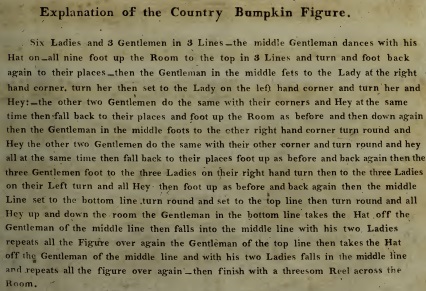
Figure 5. Campbell's Explanation of the Country Bumpkin from his c.1799 14th Book
The c.1799 Book 14 features an extensive description of a dance for nine people called Country Bumpkin (see Figure 5). It's effectively a Reel of Nine (six ladies and three men), with the added complication of a hat being passed between the men at various points in the dance. This is an unusually early publication in which to find the Bumpkin described, it could be the first such publication in England, though it's almost certainly of Scottish origin. An advert published in London in 1789 advertised the services of Mr Jenkins (The Times, 25th December 1789) at Alexander Wills' academy; he was reported to teach the Scotch Reel, the Strathspey, and the Bumpkin . Perhaps the Scottish dancing master George Jenkins Senior brought the Bumpkin to London personally (in addition to being a possible inventor or publicist of the Highland Fling).
The c.1803 Book 18 includes a version of Sir Roger de Coverley. This dance didn't follow the normal conventions for a Country Dance; a typical dance boxes the dancing figures so as to remain within the minor set of three couples, but in Sir Roger de Coverley the leading couple cross over between each of the couples in the entire longways set then lead up to the top from the very bottom of the set. This might require additional strains of music to allow time for that leading couple to travel so far, the musicians would have to remain aware of the dancing and repeat phrases accordingly. Campbell's arrangement of the dance is simpler than the better known version in Thomas Wilson's 1808 Analysis of Country Dancing though it shares the same crossing figure that Wilson used. It went on to be a very popular dance in Regency London. Campbell's version is perhaps an intermediate form of the dance later promoted by Wilson and even the novelist Charles Dickens. We've investigated this dance further elsewhere, you might like to follow the link to read more.
The c.1807 Book 22 features a dance called The Russian Ambassador's Waltz, the title is extended to add (With the Original German Figure) . The dance is a typical Country Dance, but the figures include a description of a waltz turn in abnormal detail. It's an unusually early example of a British publication describing the Waltz. Campbell wrote: The 1st Gent Set to the 2d Lady, & both go quite Round with his Right hand Round the Lady's Waist; & the Lady's Left hand Round the Gent's Waist at the Same time; the Gent takes the Lady with his Left hand by her Right hand . The Waltz was a new and controversial dance form which had been gaining in popularity in Britain since the 1790s, Campbell's description of the hold is helpfully detailed, and adds doubt to dancing master Thomas Wilson's claims to have invented the Waltz Country Dance in 1815. Campbell's choreography is the first clear evidence I know of for a Country Dance being performed using a Waltz figure, as opposed to applying normal figures in Waltz time.
There are many other interesting dances within the Campbell collections, but these signature dances stand out as being especially interesting. Many of them could have had their first publication in London within Campbell's collections; their success could be seen as a tribute to the quality and popularity of Campbell's work.
Campbell's Named Composers
Campbell, unlike many of his contemporary publishers, identified some of the composers responsible for his tunes. Such identifications are sporadic and inconsistent, but offer an insight into his sources. Of the 132 tunes with named composers I've studied, 47 of them are credited to William Campbell himself. A further two are declared to be Set by Campbell. Given that Campbell was careful to claim credit for the tunes he composed, it's reasonable to assume that the uncredited tunes were not composed by him. At least 31 further composers are named; a precise count is challenging as it's not always obvious if variants of names imply the same person (for example, are Mr Marshall and William Marshall the same person?).
The second most credited contributor was John Erhardt Weippert with 11 tunes (and not to be confused with John Michael Weippert who composed a further 4). Duncan Macintyre was credited with contributing 11 tunes (adjusting for variations in spelling), and George Jenkins Junior 7 (not to be confused with George Jenkins Senior with 2 more). Several members of the Gow family were also named; we've written about the immensely successful Gow and Jenkins families before). Many more composers were credited, around 13 were recognised for just a single tune. Most of the named composers were Scottish, including: Daniel Dow, Robert Mackintosh, Abraham MacIntosh, William Marshall, John Pringle and John Riddell (links are to their biographies at tunearch.org). Many of the tunes had previously been published in Scottish collections, though Campbell could have been the first to publish such tunes in London.
The bulk of the tunes were not credited with a composer, Campbell's sources for such tunes are not always obvious. Campbell provided a bass line for each of his scores, though other publications frequently omit them; presumably Campbell composed those accompaniments himself where required. The presence of a bass line for each tune is part of what makes Campbell's collections so interesting.
Campbell also released a later publication c.1808 (date uncertain) with the title No. 1 of Campbell's new and favorite original dances, strathspeys, reels &c, in which one of the tunes was compos'd by Miss Weippert. The Weippert family are especially interesting collaborators.
The Weippert Family
The Weipperts were an important family in London's musical scene. They, over several generations, were publishers of dances, musicians, dancing masters and band leaders. Three prominent members of the family all shared the name John Weippert which can make disambiguation complicated.
Johann Erhardt Weippert (1766-1823) was a German immigrant naturalised as a British citizen in 1801, and famed as a composer and player of the harp. Campbell's early references to Weippert are to John Erhardt. JE's band often played for concerts and dancing at Margate, examples include the Duke of St Alban's Fete (Morning Post, 6th October 1802) and duets with John Gow (another of Campbell's composers) in 1818 (Kentish Weekly Post or Canterbury Journal, 1st September 1818). He went on to become a Governor of the Royal Society of Musicians, prior to his death in 1823.
Johann Michael Weippert (1776-1831) was JE's younger brother. He followed his brother into the same trade; Campbell differentiated between the two brothers from c.1799 by referring to them as E Weippert and M Weippert. Other sources refer to JE Weippert and JM Weippert, though many more refer ambiguously either to Weippert or John Weippert. JM went on to publish many Quadrille sets in London in the 1820s, and was appointed Professor of the Harp in ordinary to His Majesty in 1827 (The Times, 26th October 1827). JM published four sets of waltzes in 1818 composed expressly by Mr J.M. Weippert, for Mr Paine's Band, and performed at Almack's and the Argyle Rooms (Morning Post, 21st February 1818) and a Grand Set of Quadrilles, performed by Paine's Band in 1819 (Morning Chronicle, 8th May 1819). His publications reverted to using the name John Weippert from c.1823, following his Brother's death.
One of the Weipperts (it's unclear which) was advertised in 1801 as accompanying Robert Mackintosh (another of Campbell's composers) at Mr Allen's City Assemblies in London (Morning Post, 17th March 1801). These events were described as being a Select Assembly and Dancing Academy to the Lovers of Pure Scotch Dancing ; Allen had Determined to spare no expense to render it superior in every respect to any other of the kind , and engaged Mr Mackintosh, from Edinburgh, whose animating notes are the life and soul of the Scotch Nobility's private dances, and is esteemed the first performer in England for strathspeys and reels. Mr Wippart plays the Harp. Whichever of the Weipperts is implied, it is clear that they (along with Campbell) mixed with the elite of London's Scottish musical and dancing society.
Both Weipperts had children who followed them into musical careers, including JM's son George Weippert who advertised his services as a dancing master from 1823 (The Times, 16th April 1823), and JE's son John Thomas Lewis Weippert who continued publishing Quadrilles in the 1830s under the name John Weippert after the death of his Uncle (and concurrently under the name J.T. Weippert); JTL also led a successful Quadrille Band, achieved Royal patronage, and had musical sons of his own (including another John who went on to run a music shop in the 1840s). The Weippert Band was even mentioned in Queen Victoria's journals of the late 1830s.
John Erhardt also had a daughter named Julia (see Figure 7), she was the Miss Weippert who composed the Marquis of Huntleys Hornpipe in No. 1 of Campbell's new and favorite original dances, strathspeys, reels &c c.1808 (date uncertain). She was said as a youth to have been a musical prodigy, A Duetto, by Weippert, on the pedal harp, and Miss Weippert (a child of eleven years of age) on the grand piano-forte, was admirably executed (Morning Post, 12th September 1805) and hosted her own annual concerts from at least 1808 (Morning Post, 13th September 1808), That young Lady played a solo on the grand piano forte; and Mr Weippert another on the harp; they were each equaly deserving of praise from the variety of their combinations, and beatifully slow movements . She married the comic actor Mr Lovegrove in 1811 (Lancaster Gazette, 15th May 1811) and died the following year (London Courier, 16th September 1812).
Several further generations of the Weippert family achieved musical success in London. Campbell's publication of one of Miss Weippert's compositions suggests that the Weipperts considered Campbell to be a friend.
Campbell's Influence
Campbell's collections of dances are of an unusually high quality compared to other publications of a similar date. The tunes are rich and varied, printed on a large format of paper, feature a bass line, identify composers and include several exotic dances. They're far from perfect however; the choreographies are often dull, barely fit the music, and the strain markers appear to have been distributed almost at random (the same is true for many other pre-Wilsonian country dance collections, so it's not unexpected). It's not clear where Campbell sourced his dancing figures from; did he create them himself, or employ someone else to do so? His 1782 24 Country Dances publication was explicitly declared to be choreographed by Francis Werner (who published Cotillion collections through Campbell until his death c.1786) but it's unclear who Campbell worked with thereafter. He may have choreographed his own figures. But how influential were Campbell's books?
There were many music shops in Georgian London that published annual collections of dances, some especially popular tunes were published by almost all of them. I've compared Campbell's catalogue to those of his contemporaries in an attempt to measure his influence - did he publish tunes before the competition, at around the same date, or later? Was he an innovator, or a follower?
Performing this analysis required a large collection of historical dance publications to work with. Such a collection was established by combining my own notes with information from the British Library, the VWML and the CDSS, in order to create a large sample of such tune books. The data remains incomplete; for example, I have access to 24 of Campbell's annual collections but not the entire set. In many cases I only know the names of the tunes in a given non-Campbellian publication, so two tunes with the same name can't be compared to ensure that they are genuinely the same. Nonetheless, the data is statistically significant. Any errors caused by false-positive name clashes should cancel out over a large enough data sample (i.e. when comparing Campbell to any other single publisher, there should be an equal number of false-positives to Campbell's advantage and disadvantage).
The following table summarises the results. Each row compares Campbell's publications to the dated publications of another major publisher. The dates of publication are taken from the covers of the works; if, for example, a collection claims to be For The Year 1799, it's assumed that it was either published in 1799 or towards the end of 1798. If both publishers appear to have published a tune in the same year then we can't gauge who was first, otherwise the table presents a tally of precedence. The estimated dates for Campbell's own collections are thought to be reliable but have the potential to be inaccurate. The numbers in parentheses show the results if we assume the estimated Campbellian publication dates are an entire year too early, they can be used to infer the degree of confidence in the results. Trading names changed over time, I've ignored that for the purposes of this comparison, merging successor businesses together where appropriate. The absolute numbers in the table below are not especially important (missing data and false-positives will ensure that most are provably wrong), it's the emergent trends that are significant.
| Publisher | Tune Names in Common with Campbell | Number Campbell published First | Number Campbell published Second | Number of indeterminate First Publication |
|---|
| Skillern | 21 | 17 (12) | 2 (4) | 2 (5) |
| Thompson | 29 | 19 (14) | 7 (10) | 3 (5) |
| Bland & Weller | 38 | 25 (15) | 4 (13) | 9 (10) |
| Cahusac | 58 | 47 (17) | 5 (11) | 6 (30) |
| Preston | 96 | 64 (32) | 15 (32) | 17 (32) |
| Longman & Broderip | 34 | 17 (9) | 15 (17) | 2 (8) |
The observed pattern is that Campbell usually published tunes before his contemporaries. That's not to say that they copied from Campbell, just that his publications helped to influence what became popular such that other publishers would want to republish them; we might say that he was ahead of the curve in promoting popular tunes. This is most noticeable in comparison to the Cahusac and Preston collections, they frequently published tunes the year after it's estimated that Campbell published them. Most of the firms in the table above were active throughout the period that Campbell was publishing, so Campbell didn't receive any pre-existence advantages (firms that started later would have to catch-up with publishing popular tunes from the recent past, skewing the results to their disadvantage).
The Longman and Broderip collections are a little different. They often published tunes ahead of Campbell; their results are skewed by just a single publication, their Twenty-Four Country Dances for the Year 1796 contained 7 tune names in common with Campbell's 1795 Book 10. That's unlikely to have been coincidental. They also published a separate and undated Selection of Country Dances, Reels &c. which ran to at least 6 editions, omitted from the table above due to dating uncertainty. This second collection has a large overlap with the Campbell collections. I date them from 1791 to 1796 based on the 4th edition having been registered for copyright at Stationer's Hall in 1794. The c.1791 first edition of this collection contains at least 14 tunes (out of 24) which were first published by Campbell in his books 1 to 3; the c.1792 second edition contains at least 20 tunes (out of 24) which were first published by Campbell in his books 3 to 6. Later editions do not share this overlap. It appears that those two specific works were directly influenced by Campbell, they don't merely overlap, their content is identical (the tunes, accompaniments and dancing figures are identical; even the errors are faithfully copied from Campbell). Things get even more confused if Campbell's 24 Country Dances for 1796 is compared with Longman & Broderip's 24 Country Dances for 1795; the copies of these works at the British Library are mostly identical (to the extent that the same plates seem to have been used for printing both publications); a similar statement can be made when comparing Campbell's collection for 1793 with Longman & Broderip's collection for 1791. It's not clear why they overlap, but it's not accidental and could imply a collaboration. Perhaps they made an agreement to share plates with each other, or perhaps the cover and contents of publications have been muddled in the archives. With the exception of these specific highly-similar collections, the bulk of their publications have little overlap with Campbell, they were sometimes ahead of Campbell in publishing new tunes.
Many other music stores operated in London throughout this period and printed collections of Country Dances. I lack sufficient data to perform an analysis for Goulding and Dalmaine, Thomas Budd etc.. The firm of Button and Whitaker were especially important in the Regency period but they didn't begin publishing until the very end of Campbell's career, there's little potential for overlap. The awareness and relevance of Copyright legislation grew in the 1810s, that may have had a chilling effect on the republication of tunes across vendors; Campbell's publications flourished at a time when most tunes were still considered (to the extent that the issue was considered at all) to be in the public domain, they could be widely reprinted without attribution. We've considered the issues of Copyright for Country Dances in a previous research paper.
Campbell's Premium Publications
The table below lists Campbell's publications, with links to source material where available. Not many of these publications are available on the internet at time of writing; if you have copies, do consider scanning or photoing them, and sharing them with the community of enthusiasts who enjoy recreating these dances. If you'd like any assistance in doing that, or have anything else to share, do please contact us.
Campbell's annual collections of Twenty Four Country Dances for the Year .... are omitted from this list, but appear in a separate table below. This list also omits any publications printed on behalf of another named dancing master (e.g. those of Francis Werner, Nicholas Lemaire, etc.). This list is based on the collections that Campbell published in his own name.
| Work & Date | Image | Comments |
Sixteen New Dances
c.1780 |
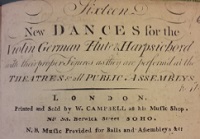
|
The contents include: Fischers Hornpipe, The Maid of the Mill, Athol House, The Twins, The Milk Maid, The Installation, The Yorkshire Lads, Mother Shipton, The Swedish Dance, Fischers Allemand, The Tempest.
Full Title: Sixteen New Dances for the Violin, German Flute & Harpsichord, with their proper figures as they are performed at the Theatres & all Public Assemblies.
Image © THE BRITISH LIBRARY BOARD, a.9.e.(6.) ALL RIGHTS RESERVED
|
Campbell's 1st Book of New and Favorite Country Dances & Strathspey Reels
c.1786 |
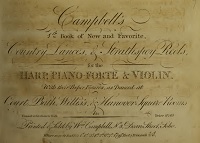
|
The contents are: Jenny Sutton, Lewie Gordon Strathspey, The Opera Reel, Mrs Casey, The Village Maid, Miss Hamersley's Allmand, La Nouvelle Marie, Hamilton House, Sir John Stewart of Grandtullys Strathspey, Captain Macduff, The Dutchess of Gordon's Strathspey, Lady Betty Cochrans Reel, Miss Oswalds Reel, Corimonies Strathspey, Miss Stewart's Reel, Miss Campbells Reel, Mrs Duncans Fancy, The Honourable Peace, Miss Forbes Fancy, Raza's Rell.
Full Title: Campbell's 1st Book of New and Favorite Country Dances & Strathspey Reels, for the Harp, Piano-Forte & Violin. With their Proper Figures as Danced at Court, Bath, Willis's & Hanover Square Rooms &c.. Price 2s6d.
|
Campbell's 2nd Book of New and Favorite Country Dances & Strathspey Reels
c.1787 |
|
The contents are:
Lady Townsend's Whim, Loch Erroch (a strathspey), Lamour de Village, The Humours of Burrow, The Magic Miror, The New Fair, Lady Grant of Dalvey's Reel, Mrs. Grahams Delight, The Hurly Burly, Miss Grant of Monymusk, Miss Vickor's Delight, Epping Chace, The New Post, Miss Dalrymple's Reel, Jackie Latin, Omai, Indian Chief, La Belle Arsene, La Comtesse du Nord.
Full Title: Campbell's 2d Book of New and Favorite Country Dances, & Strathspey Reels, for the Harp, Piano-Forte & Violin; with their Proper Figures as Danced at Court, Bath, Willis's, & Hanover Square Rooms &c. Price 2s6d.
I'm indebted to Heather Clarke and the Mitchell Library for supplying the list of contents for this collection.
|
Campbell's Third Collection of the newest and most favorite Country Dances & Cotillions
c.1788 |
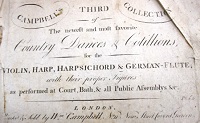
|
The contents are: The Highland Plaid or the Tartan Plaiddie, Trip to Hatfield House, La Visite, Marshall Fancy, The White Cockade, The Sandwich, Morgan Ratler, The Haydn, The Royalty, La Plasir L'ete or The Haunted Tower, Ascot Races, Dibdins Fancy or The Princes Favorite, Lady Salisbury's Fancy, General Elliot or Gibralter, La Belle Couquette, Miss Weddenburns Reel, La D'Orvilliers, La Pastorale.
Full Title: Campbell's Third Collection of the newest and most favorite Country Dances & Cotillions, for the Violin, Harp, Harpsichord & German-Flute, with their proper figures as performed at Court, Bath, & all Public Assemblys &c.. Price 2s6d.
Image © Cardiff University
|
Campbell's Fourth Collection of the newest and most Favorite Country Dances & Cotillions
c.1789 |
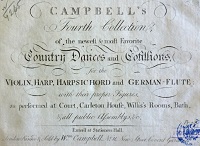
|
The contents are: Carlton House or La Sauveniese, The Princes Favourite, The Perthshire Hunt, Hamilton House, The Duke of York's Cotillion, Lady Gowers Fancy, Peggy Perkins, Pleyels Fancy, The Haunted Tower, The Naval Review, The Evening Brush, Miss Napiers Fancy, The Fife Hunt, The Tartan Bonnet, The Countess of Haddintons, La Boulanger (N.B. This may be Danced by any Number of Couples), La Belle Isabell, La St. Albin, Trip to Hawkhurst, The Honble Miss Kennairds Reel (by G.Jenkins), La Champetre, Miss Baringtons Fancy (by G. Jenkins), The Gobyo, La Mellan, Una's Lock, The Village Fair, Shane's Castle.
Full Title: Campbell's Fourth Collection of the newest and most Favorite Country Dances & Cotillions, for the Violin, Harp, Harpsichord and German-Flute, with their proper Figures as performed at Court, Carleton House, Willis's Rooms, Bath, & all public assemblys &c.. Price 2s6d.
|
Campbell's Fifth Collection of the newest & most favorite Country Dances and Reels
c.1790 |
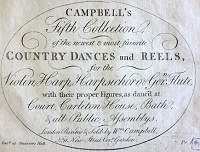
|
The contents are: Blue and Buff, La Jarnovik, The Duke of Clarences Fancy, The Irish Washer Woman, Money in Both Pockets, Miss Blair's Reel, The Munster Lass, The Woodman, Warwick Castle, The Manor of Wickley, The Archers Dance, Parsons Delight, The British Hero, Cosey's Jigg, Jackson's Night Cap, The Villagers, Miss Gunning, Stour Lodge, New Storace, A Trip to Strasburgh, The Widows Wish, Ah Ça Ira, The Atholl Reel, The Humours of Kildare.
At lest one surviving copy of this work also includes a further dance named Sir Hugh Munro, of Fowles Reel, or Kempshot hunt; this final dance may have been added to subsequent editions of the publication.
Full Title: Campbell's Fifth Collection of the newest & most favorite Country Dances and Reels, for the Violin, Harp, Harpsichord and Gern-Flute, with their proper Figures, as danc'd at Court, Carleton House, Bath, & all Public Assemblys. Price 2s6d.
|
Campbell's Sixth Collection of the newest & most favorite Country Dances and Reels
c.1791 |
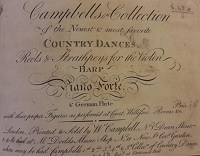
|
The contents are: Lady Shaftsbury, Sweet Richard, Lady Charlotte Lenox's Strathspey, Le Deroutte De Palatine or Miss Benticks Fancy, The New London, The Duchess of Yorks Waltz, The Cumberland Reel or Unas Loch, Miss Davidsons Jig, The New Gypsie, Mac's Fancy, Lochaber Rant, The Marchioness of Worcester's Favorite, Miss Campbell of Shawfield's (by Mr Pollock), Lady Elizabeth Stanleys Jig (by Mr Pollock), Lady Charlotte Campbell Reel, Dalmor Parke, Lady Augusta Murray's Strayspay, The Duke of York's Quick Step, Lady Virgina Murrays Fancy, York House, Lady Portmore's Fancy, The Braes of Ballendallock.
Full Title: Campbell's 6th Collection of the Newest & most favorite Country Dances, Reels & Strathspeys for the Violin, Harp, Piano Forte & German-Flute, with their proper Figures as performd at Court, Willisses Rooms, &c. Price 2s6d.
Image © THE BRITISH LIBRARY BOARD, b.49.e.(6.). ALL RIGHTS RESERVED
|
Campbell's Seventh Collection of the newest & most Favorite Country Dances and Cotillions
c.1792 |
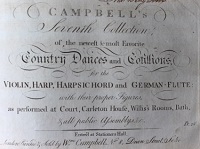
|
The contents are: The Duke of Gordons Birth Day, Trip to Clascow, The 19 of Febry, The Wild Irishman, The Isle of Skey, The Irish Milk Maid, Mc.Queen's Reel, The 3 of May, Loch Ranachei Side, Mrs. Gordons Strathspey, Miss Johnstons Reel, Capt. Mc. Donalds Fancy, Carleton House, The Breas of Tilleymett, Trip to Dublin, The Highland Wedding, Jannie Dang the Weaver, The Fox, Miss Stwarts Reel, La Plaisire de Plombiere, New Rigg'd Ship, Mrs. Fleming Strathspey, The Garman Spaw Waltz, The Spaw Promenade, La Duches, Weipperts Fancy, A Trip to Spaw.
Full Title: Campbell's Seventh Collection of the newest & most Favorite Country Dances and Cotillions, for the Violin, Harp, Harpsichord and German-Flute, with their proper Figures, as performed at Court, Carleton House, Willis's Rooms, Bath, & all public assemblys. Price 2s6d.
Image © VWML, EFDSS
|
Campbell's Eighth Collection of the newest & most favorite Country Dances and Reels
c.1793 |
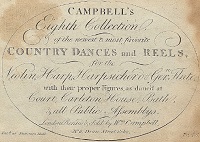
|
The contents are: Prince Edwards Fancy, The Village Reel, Lord Millington's Strathspey, A Trip to Holland, Athole Brose (by Niel Gow), A. Marshall's Reel (by Wm Marshall), Back of the Change House, Mr Hamilton of Wishaws Reel (by William Gow), Haste to the Camp, Miss Cummings Fancy (by Mr McIntyre), Lady Charlotte Campbells Reel, Jenny Nettles, Lady Charlotte Percys Reel (by Mr Pollock), Miss Rose's Fancy of Jamaica (by Mr C. McNab), Doncaster Races (by Mr McIntyre), Miss Bennets Jigg (by Mr Pollock), The Loyal Soldier, Lady Madelina Sinclairs Strathspey, Lord Macdonalds Reel, A Trip to the Camp (by Mr McIntyre), Lady Aucklands Reel, Mr Saml Roses Reel of Jamaica (by Mr McNab).
Full Title: Campbell's Eighth Collection of the newest & most favorite Country Dances and Reels, for the Violin, Harp, Harpsichord & Gern-Flute, with their proper Figures, as danc'd at Court, Carleton House, Bath, & all all Public Assemblys. Price 2s6d.
Image © National Library of Scotland
|
Campbell's 9th Book of New and Favorite Country Dances & Strathspey Reels
1794 |
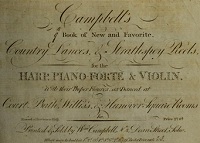
|
The contents are: The Princess Royal, Lord Elgin's Strathspey, Windsor Hunt, Miss Welsh's Fancy, Lady Charlotte Bruce's Reel, Col Montgomery's Quick Step, Miss Francklyn's Reel, Miss Colcrofts Favorite, Lady Clinton's Fancy, Mrs Cholmondley's Reel, Captn McDonald's Reel, Miss Hammersly's Fancy, Highland Fair, Tam na hurith Strathspey, Miss Call's Reel, Duff House a Strathspey, Jannies Babie, La Triumphe, The Laises of Stewarttown, Ally Croaker, Castle Grant, None so Pretty.
Full Title: Campbell's 9th Book of New and Favorite Country Dances & Strathspey Reels, for the Harp, Piano-Forte & Violin, with their Proper Figures, as Danced at Court, Bath, Willis's, & Hanover Square Rooms &c. Price 2s6d.
|
Campbell's 10th Book of New and Favorite Country Dances & Strathspey Reels
1795 |
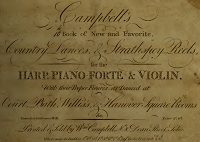
|
The contents are: The Princess of Wales's Strathspey (by W.C.), Prince William of Gloucester's Favorite (by J. Gow), Admiral McBride's Hornpipe (by W.C.), Hilton Lodge, The new German Waltze, Madam Del Caro's Reel, Marchioness of Blandfords Reel, Miss Onslows Reel (by D.Mackenzie), Mid Lothian, The Duke of Gloucesters Reel, Dance Basse, Mrs Hermitage's Fancy, Morpeth Rant, Miss Willis's Strathspey (by D.Mackenzie), Miss Browers Strathspey (by D.Mackenzie), Miss Louisa Drummonds Reel, Miss Devon's Reel (by D.Mackenzie), Col Mackays Reel, The Little Assembly, Mrs Lester or the Brunswick (by Weippert), The Russian Dance, Cammolan, Miss McCloud's Fancy, Miss Devereux Reel (by W.C.), The Breast Knot, Miss Ogleves Fancy, You're Welcome Home Reel (by McIntosh Junior), The Royal Wedding, Miss Sharpe of Hoddoms Reel (by McIntosh Junior).
Full Title: Campbell's 10th Book of New and Favorite Country Dances & Strathspey Reels, for the Harp, Piano-Forte & Violin, with their Proper Figures, as Danced at Court, Bath, Willis's, & Hanover Square Rooms &c. Price 2s6d.
|
Campbell's 11th Book of New and Favorite Country Dances & Strathspey Reels
c.1796 |
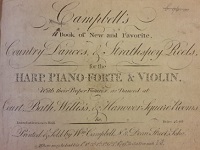
|
The contents are: Duchess of Yorks Reel (by J.Gow), The Perthshire Highlanders (by W.Campbell), Lady Louisa Gordon (by J.Gow), Mrs Carters Strathspey (by W.Campbell), Young Simon Strathspey (by Nathl Gow), Tulloch Gorum, Melbourne House (by Jenkins Junr), Lady Charllotte Bentincks Reel (by W.Campbell), Rocks of Cashel (Set by W.Campbell), St Ann's Fancy, Lady Cochrans Reel (by Dl Dow), The New Barracks, Miss Christina Stewarts Reel (by D.Macintyre), The Minors Waltz, Lady Homes Reel (by D.Dow), Neil Gows Fancy, Miss Burrows Reel (by Jenkins Junr), Dartford Lodge, Go to Berwick Johney, Mrs Major Hamiltons Reel (by McIntosh Junr), Lady Charllotte Villers Reel (by McIntosh Junr), Siege of Manheim, The Highland Bonnet (by W.Campbell), The Bob of Fattercairn, The new Isla Reel (Set by W.Campbell), Drops of Brandy, Belvediere of La Mountaineers, Dusty Miller.
Full Title: Campbell's 11th Book of New and Favorite Country Dances & Strathspey Reels, for the Harp, Piano-Forte & Violin, with their Proper Figures, as Danced at Court, Bath, Willis's, & Hanover Square Rooms &c. Price 2s6d.
Image © THE BRITISH LIBRARY BOARD, b.96. ALL RIGHTS RESERVED
|
Campbell's 12th Book of New and Favorite Country Dances & Strathspey Reels
c.1797 |
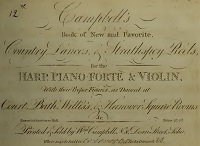
|
The contents are: The Russians Rant, Neil Gow's Strathspey (by D.Macintyre) This and the following may be danced as a new Medley, De'el's Dead, Lady Jane Douglas' Strathspey (by W.C.), Miss Campbells Fancy (by W.C.), Mrs Sandy's Fancy (by D.Macintyre), Richer's Hornpipe, Miss Zoffany Weippert Waltz, Miss Cruickshanks Strathspey (by W.C.), Moll in the Wad, The Irsh quick Step, Mrs Murray of Auchtentyre, Miss Katty Hall's, The Highland Skip, The Braes of Marr, Cameron has got his Wife again, Colonel Mackenzies Reel (by W.C.), Miss Bishops Waltz (by Weippert), Lady Cholmondley's Waltz (by Weippert), Lady Mary Stopford's Reel, Merry Sherwood, or the Straw Bonnet, Dunse dings all, Mrs Stewart's Reel, The Braes of Bowhether, Lady Hamilton's Reel (by W.C.), Bung your Eye.
Full Title: Campbell's 12th Book of New and Favorite Country Dances & Strathspey Reels, for the Harp, Piano-Forte & Violin, with their Proper Figures, as Danced at Court, Bath, Willis's, & Hanover Square Rooms &c. Price 2s6d.
|
Thirteenth Book of Strathspey Reels, Waltz's & Irish Jiggs
1798 |
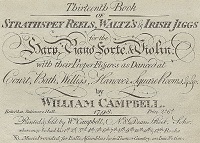
|
The contents are: Lord Duncans Victory, I'll make you be fain to follow me, Sir Henry Trollope's Fancy, Philly McCue, Madam Didelots Reel, Lady Charlotte Bentincks Waltz, Simpsons Reel, The Honble Mrs Maules Reel (by Robt Mackintosh), Miss Farquharsons Strathspey or Little Peggys Love (by Mr Marshall), Perthshire Volunteers, The Countess of Lauderdales Reel (by A. McIntosh), The new Tartan Plaidie, Hey to Couper, Miss Ann Amelia Stewarts Stratspey, The Royal Artillery Whim or the 11th October, The Wertemberg Waltz, The Broken Brig of Stirling, Miss Cummings Fancy, Bugle Horn, The Venerable, Stewart Cumming, Lady Bairds Reel or Little Fanny Love, Go to the Devil and shake yourself (two tunes), Miss Pemberton's Reel (by A. McIntosh).
Full Title: Thirteenth Book of Strathspey Reels, Waltz's & Irish Jiggs, for the Harp, Piano-Forte & Violin; with their Proper Figures as Danced at Court, Bath, Willis's, & Hanover Square Rooms &c&c. by William Campbell. Price 2s6d.
Image © National Library of Scotland
|
Campbell's 14th Book of New and Favorite Country Dances & Strathspey Reels
c.1799 |
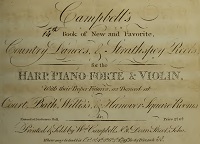
|
The contents are: Lady Charlotte Campbell's Waltz, Gusendall Bay, Lord Nelson's Waltz, Miss Kitty Campbell's Strathspey, Earl Marshalls Reel, Miss Judwins Waltz (by M.Weippert), Miss Wieses Waltz (by M.Weippert), Miss Sibbalds Waltz (by M.Weippert), Mrs Garden of Troup's Strathspey, Miss Athill's Reel, Marquiss of Lorn's Strathspey (by D.Macintyre), Miss Kitty Campbells of Shawfields Reel, The Wanton Wife of Hull (by Mr Payne), Croppies lie down, George Kinloch, Mrs Cruickshank's Fancy, Grieg's Pipe's, The Country Bumpkin, Jackson's Dream and Roodulum an Irish Medley, Roodulum, I have a Wife of my ain, Sally Kelly, A Friend to the Poor (by H.Fleming).
Full Title: Campbell's 14th Book of New and Favorite Country Dances & Strathspey Reels, for the Harp, Piano-Forte & Violin, with their Proper Figures, as Danced at Court, Bath, Willis's, & Hanover Square Rooms &c. Price 2s6d.
|
Book 15th of Strathspey Reels, Waltz's & Irish Jiggs
c.1800 |
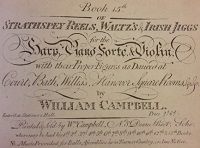
|
The contents are: The Devil among the Taylors, Delvin Side, Adl Mitchell's Waltz (by E. Weippert), Lady Lucy Ramsey's Favorite, The Grinder, The Lilly, Lochspey Side (by Wm Campbell), Belvoir Castle, or the Duke of Rutland's Birth Day (by J. Gow), The Priest in his Boots, Mr Edwards's Hornpipe, Lady Charlotte Hamilton's Reel, Sir Sidney Smith's Waltz (by E Weippert), Miss Bell's Reel (by Wm Campbell), Ramah Droog, Lord Seymour's Reel, Isle of Man, a New Reel (by Wm Campbell), Castle Bar (by Wm Campbell), Miss Eastwood's Fancy, Mr Wills's Strathspey, Swinley Camp, Miss Maxwell's Reel, Noorah Creenah (Irish), The Highway to Edinburgh (by Wm Campbell), Lord Eglinton's Reel, Roy Stewart's Reel, Callender House.
Full Title: Book 15th of Strathspey Reels, Waltz's & Irish Jiggs, for the Harp, Piano-Forte & Violin; with their Proper Figures as Danced at Court, Bath, Willis's, & Hanover Square Rooms &c&c. by William Campbell. Price 2s6d.
Image © THE BRITISH LIBRARY BOARD, b.96. ALL RIGHTS RESERVED
|
Book 16th of Strathspey Reels, Waltz's & Irish Jiggs
1801 |
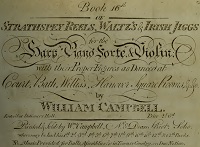
|
The contents are: The Capture of Seringapatam (by D.Macintyre Calcutta), Sir David Hunter Blairs Reel (by D.H.B.), Garey Owen. Harlequin Amulet or the Majic of Mona (by Jackson of Cork), Miss Read's Reel (By Wm Campbell), The Union (by E.Wippert), Colonel Robertsons Strathspey (by W.Campbell), Pizarro (by Wm Campbell), Lady Barbara Ashley Coopers Strathspey (by Mr Jenkins), Dear Dublin (by Mr Jenkins), Mr Harry Angelo Junrs Favorite (by Mr Jenkins), Mr A Cummings Fancy, The New Bridge of Ayr (by John Riddle), The Blue Bells of Scotland, Miss Margaret Grants Reel, The Airshire Lasses, Mrs Blair of Blairs Reel, Miss Adams Strathspey (by Wm Campbell), Halloween (by J. Sanderson), Lady Hampdons Reel (by J.Gow), The Pentonville Assembly, Smiths Orange & Fork (by J.Sanderson), Fight about the Fire Side, The Countess of Antrim (by J.Banks), Crewe Hall (by J.Banks), The Right Honble Lady Elizabeth Grevilles Waltz (by E.Weippert).
Full Title: Book 16th of Strathspey Reels, Waltz's & Irish Jiggs, for the Harp, Piano-Forte & Violin; with their Proper Figures as Danced at Court, Bath, Willis's, & Hanover Square Rooms &c&c. by William Campbell. Price 2s6d.
|
Campbell's 17th Book of New and Favorite Country Dances, & Strathspey Reels
c.1802 |
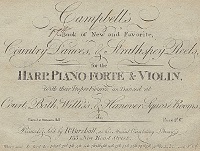
|
The contents are: Loch Aloie (A Strathspey), Ride a Mile, Lady Fitzgeralds Reel, Mr R. Downies Fancy (by J. Jenkens), Paddy O'Flanagan, Lady Morpeth's Waltz, Lady Catherine Blyth, The Braes of Mar (A Strathspey), Clean Peas Straw, Miss Pratts Reel (by J. Jenkins), Arabella, Castle Down, Miss Louisa Rushs Reel, The Isla Reel, Miss Mary Ram's Fancy, The charms of Kildare, Campbells are coming, Sleepy Moggy, Wags of Windsor, Lady Mary Ramsay, Jolly Boat, Pettycoat Loose, Bognor Rocks or Jarnovicks Reel.
Full Title: Campbell's 17th Book of New and Favorite Country Dances, & Strathspey Reels, for the Harp, Piano-Forte & Violin; with their Proper Figures as Danced at Court, Bath, Willis's, & Hanover Square Rooms &c. Price 2s6d.
Image © National Library of Scotland
|
Campbell's 18th Book of New and Favorite Country Dances, & Strathspey Reels
c.1803 |
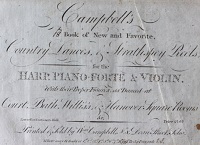
|
The contents are: Her Royal Highness the Princess Charlottes Favorite, Lady Mary Douglas, The Honble Mrs Andrew Ramsay's Strathspey (by J. Gow), Sir Francis Burdet (by W.C.), Sir Roger de Coverley, Lord John Campbells new Strathspey (by the Late Mr Macintyre), Perthshire Lasses (by W.C.), The PloughBoy's Reel (by W.C.), Mr Jenkins Shan Truish, Norry's Cake, Push about the Jorum, This is not my ain House, Mr Macintyres Reel, Cool o Gurro, Sullivans Fancy, Invernesshire Hunt (by W.C.), Plsh le Fawna, Lady Lucy Ramsays Reel (by D.Macintyre), Lord Kildare's Reel (by W.C.), The Honble Edward Spencer Cowpers Fancy (by Thos Dye), The 14th of February, The Devils Hop, Bogner Rock, Amelia.
Full Title: Campbell's 18th Book of New and Favorite Country Dances, & Strathspey Reels, for the Harp, Piano-Forte & Violin; with their Proper Figures as Danced at Court, Bath, Willis's, & Hanover Square Rooms &c. Price 2s6d.
Image © VWML
|
Campbell's 19th Book of New and Favorite Country Dances, & Strathspey Reels
c.1804 |
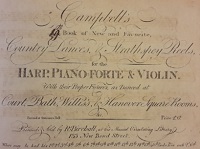
|
The contents are: Lady Caroline Lee's Waltz, Paddy O'Raferty, Capt Mackenzie's Reel (by W.C.), Lord Grantham's Whim, or the Irish Quick step (by T Essex), Athole House, Off she goes, or Follow her over the borders, The Honorable Miss Ward's Fancy (by W.C.), Miss Seymour's Reel (by W.C.), Had a Wad Hame, Miss Knox's Fancy (by W.C.), The Drummer, or Good Morning to your Night Cap, Miss Trotters Reel (by W.C.), St Kildas's Reel, Lady Agnes Percy's Reel (by W.C.), Light and Airy, Miss J Clarke's Reel (by A. Mackintosh), Miss Bulman's Favorite (by A. Mackintosh), Over the Boggie wi my Love, Coll. McBains, or the Davens Reel, The 92nd or Marquis Huntly's Highlanders (by W.C.), The New Royal Quick Step (by W.C.), Loyal North Britons (Mr J. Barber), Lady Harriot Cavendish's Trip, Miss Mackenzie's Strathspey (by Mr Mackenzie), Capt Walton Campbell's Strathspey (by W.C.), Lodoiska.
Full Title: Campbell's 19th Book of New and Favorite Country Dances, & Strathspey Reels, for the Harp, Piano-Forte & Violin; with their Proper Figures as Danced at Court, Bath, Willis's, & Hanover Square Rooms &c. Price 2s6d.
Image © THE BRITISH LIBRARY BOARD, b.96. ALL RIGHTS RESERVED
|
Campbell's 20th Book of New and Favorite Country Dances, & Strathspey Reels
c.1805 |
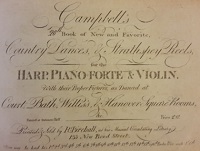
|
The contents are: Murphy Delaney, Lady Montgomeries Reel, Mrs Macintire or Lady Amelia Stewarts Reel, Miss Grace Grants Reel, Lady Towns, Miss Montgomeries Reel, The Duke of Yorks Birthday, Mrs McKenzie's Strathpey, The Weymouth Fete, Off She Goes, Lady Maria Parkers Strathspey, Lord Homes Reel, Over the Moor She ran, Lady Charlotte Perceys Fancy, Brechin Castle a Strathspey & Miss Vearie Hays Reel (Medley), The Round Tower, The Duchess of Bedfords Stathspey, La Bella Rosa, Lady Mary Bentincks Fancy, Major Macdonalds Rant, Gough House, Bridge of Lodi, The Bath Waltz.
Full Title: Campbell's 20th Book of New and Favorite Country Dances, & Strathspey Reels, for the Harp, Piano-Forte & Violin; with their Proper Figures as Danced at Court, Bath, Willis's, & Hanover Square Rooms &c. Price 2s6d.
Image © THE BRITISH LIBRARY BOARD, b.96. ALL RIGHTS RESERVED
|
Campbell's 21st Book of New and Favorite Country Dances, & Strathspey Reels
1806 |
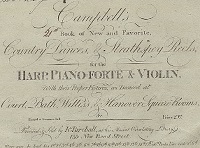
|
The contents are: The Countess of Moira, The Royal Victory, or Lord Nelson's Glory, Caber Feigh, The Elouis, or The Weymouth Fete, La Toison d'or, The Straburg Waltz, I'll go no more to yon town, Thro' the wood of Favie, Mary Gray, Lady Homes, Lenox's Love to Blantyre, Bob and John, or Love and Wiskey, Mrs Johnston of Houghton Hall, The Installation, Friendly Assembly, Caro Dolce, The Cumberland Rant, Colonel McLeods Reel, Mrs Robertsons Strathspey of Abington Street, Lady Hamilton, The Honey Moon, The Russian Waltz, The Braes of Auchtertyre, The Lakes of Wicklow, Cape Trafalgar, Lord Collingwood.
Full Title: Campbell's 21st Book of New and Favorite Country Dances, & Strathspey Reels, for the Harp, Piano-Forte & Violin; with their Proper Figures as Danced at Court, Bath, Willis's, & Hanover Square Rooms &c. Price 2s6d.
Image © National Library of Scotland
|
Campbell's 22nd Book of New and Favorite Country Dances, & Strathspey Reels
c.1807 |
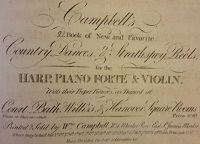
|
The contents are: Lady Elizabeth Percy's Fancy (by Mr Pullock), Lady Sophia Cecil's Fancy (by Mr. Pullock), Lord Moira's welcome to Scotland (by D.Macintyre), Mr O. Gallagher, or success to the Petticoat, Mrs Bilingcrofts, or the New Waltz (by W.C.), Mr J. Walkers Fancy, Donald o Cready (or Mordoch o Rouck), Alnwick Lodge (by Mr Pullock), The Marquiss of Huntleys Quick Step (by W.C.), Iron Tower, The Russian Ambassador's Waltz (with the original German Figure), Rugantino, Lord Montgomerie's Reel (by W.C.), New Claret, What the D--l ails you, Bonaparte in a Knapsack, The Return, Mr H.Brown of Fulham Fancy (by Wm Campbell), Up & war them a Willie, Willie Winks a Strathspey, Eight Men of Moudardi, Denny's Hornpipe, La Ridicule, a Cotillion, Culloden House (by W.C.), Paddy O Carol, A Favorite Irish Air.
Full Title: Campbell's 22nd Book of New and Favorite Country Dances, & Strathspey Reels, for the Harp, Piano-Forte & Violin; with their Proper Figures as Danced at Court, Bath, Willis's, & Hanover Square Rooms &c. Price 2s6d.
Image © THE BRITISH LIBRARY BOARD, b.96. ALL RIGHTS RESERVED
|
No. 1 of Campbell's New and Favorite Original Dances, Strathspeys, Reels &c
c.1808 (date uncertain) |
|
The contents are: Marquis of Huntley's hornpipe (composed by Miss Weippert), The Runaway, Prussian Waltz, Morgiana, Princess Dolgorucky, Fairy Prince, Lady Ann Stewart's Reel,
The Miller of Drone.
Miss Weippert (see Figure 7) is declared to be the composer of the first tune in the collection. Many of these tunes were highly popular and were widely printed in other collections at a similar date. Campbell added the comment NB Most of these Airs are Property .
Full Title: No. 1 of Campbell's New and Favorite Original Dances, Strathspeys, Reels &c.
|
Campbell's 23rd Book of New and Favorite Country Dances, & Strathspey Reels
c.1808 |
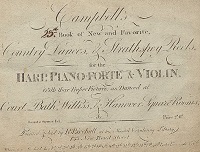
|
The contents are: Labyrinth, The Ridicule a Reel, The merry Lads of Air, Foley House, Miss Bass Waltz (by E. Weippert), The Nameless, Knole Park, Major David Stewarts Strathspey (by Daniel Menzeis), The Sylph, The Fortress, Sir Richard Strachan or the freinds of Wapping, Mrs Spicer's Fancy, Mrs Owen's Fancy (by W.C.), King of the Catti, Masquerade Dance (by W.C.), Tars of the Victory, Fairy Dance, Miss Williams Fancy, Highland Cottage, Margate Cliffs (by E. Weippert), Three Sisters, or Miss Hunter's Waltz (by E. Weippert), Lord Collingwood's Hornpipe (by E. Weippert).
Full Title: Campbell's 23rd Book of New and Favorite Country Dances, & Strathspey Reels, for the Harp, Piano-Forte & Violin; with their Proper Figures as Danced at Court, Bath, Willis's, & Hanover Square Rooms &c. Price 2s6d.
Image © National Library of Scotland
|
Campbell's 24th Book of New and Favorite Country Dances, & Strathspey Reels
c.1809 |
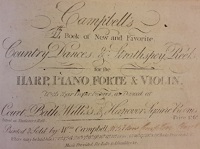
|
The contents are: Prime of Life, Calabria, Grimaldie, The fair African, The Marquis of Huntleys Highland Fling, Shaw Steuart, Mrs Mackenzie, Cameron of Loehil's Reel, The Charms of the Fair, Burton House, The Opera Hornpipe, Trip to Liverpool, The Merry Meeting a Reel, South Downs, Gartland, General Hope's Quick March, Sir David Hunter of Blair's New Reel, Harrogate Assembly, Duke of Clarences Hornpipe, Johney Pringle, Russian Dance, Montrice, The Whim.
Full Title: Campbell's 24th Book of New and Favorite Country Dances, & Strathspey Reels, for the Harp, Piano-Forte & Violin; with their Proper Figures as Danced at Court, Bath, Willis's, & Hanover Square Rooms &c. Price 2s6d.
Image © THE BRITISH LIBRARY BOARD, b.96. ALL RIGHTS RESERVED
|
Campbell's 25th Book of New and Favorite Country Dances, & Strathspey Reels
c.1810 |
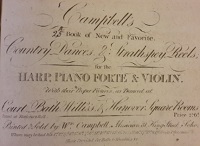
|
The contents are: Juliana, Talavera, Michael Wiggins in Ireland (by W.C.), Crop the Croppies, Susana, The Persians Farewell, The Royal Hunt, Civility, Princess Charlotte of Wales Waltz, Miss Hopes Reel (by J. Pringle), The Peasants (by W.C.), The New Theatre, The Horatio (by W.C.), The Devonshire Hunt (by W.C.), La Terza, The Persians Reveille, Lord Wellingtons Waltz (by J.M.Weippert), Mr Millers Hornpipe (by W.C.), The Barbara, Miss Flora Mac Donalds.
Full Title: Campbell's 25th Book of New and Favorite Country Dances, & Strathspey Reels, for the Harp, Piano-Forte & Violin; with their Proper Figures as Danced at Court, Bath, Willis's, & Hanover Square Rooms &c. Price 2s6d.
Image © THE BRITISH LIBRARY BOARD, b.96. ALL RIGHTS RESERVED
|
Campbell's 26th Book of New and Favorite Country Dances, & Strathspey Reels
c.1811 |
|
The contents are: The Princes Fete, Julia's Cottage, Miss Haig of Bemmerside Strathspey, The Strasburgh Dance, La Mareschal or The Regency, The Recovery, Gm:g, Lady Matilda Bruce, Voulez vous Dancez, The Departure, The Countess of Buchan's Strathspey, The Chasse, The Tank, Miss Digby, Miss Wellesley's favorite, Banosse, Phebillia, Miss Scot of Harden, Draycot House, Mertoun House, Maria.
Full Title: Campbell's 26th Book of New and Favorite Country Dances, & Strathspey Reels, for the Harp, Piano-Forte & Violin; with their Proper Figures as Danced at Court, Bath, Willis's, & Hanover Square Rooms &c. Price 2s6d.
|
Campbell's 27th Book of New and Favorite Country Dances, & Strathspey Reels
c.1812 |
|
The contents are: Moscow, The Burlesque (by W.C.), Figaro, Miss Jeanny Cameron's Strathspey (by J. Gow Junior), The new Russian Waltz, Mrs McLeod of Rasay, Wellington and Victory, Miss Baird of Soughton halls Reel, The Devonshire (by J. Gwillim), The Muses, Miss S. Thomas (by J. Barber), Blandford House (by J. Gwillin), What next (by J.G.), Miss Jessy Robertson's Reel (by W.C.), The Cossack's Dance, Calver Lodge, Lady of the Lake, Lady Caroline Bertie, Lady Charlotte Cholmondeley's fancy (by W.C.), Harriett & Sophias Waltz (by J. Barber), Salamanca.
Full Title: Campbell's 27th Book of New and Favorite Country Dances, & Strathspey Reels, for the Harp, Piano-Forte & Violin; with their Proper Figures as Danced at Court, Bath, Willis's, & Hanover Square Rooms &c. Price 2s6d.
|
Campbells Favorite Set of Country Dances & Strathspey Reels &c, for the Year 1815 |
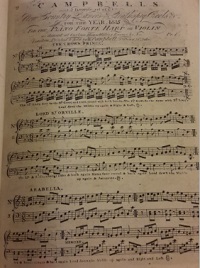
|
The contents are: The Crown Prince, Lord St Orville, Arabella, The Saxon Dance, The Temple of Concord, The Legacy, The Royal Visitors, The Emperor of Russia, Genl Prince Blucher's Victory .
Full Title: Campbells Favorite Set of Country Dances & Strathspey Reels &c, for the Year 1815, for the Piano Forte, Harp or Violin. As danced at Carlton House, Willis's Rooms, &c, &c. Pr 1s.
Image © THE BRITISH LIBRARY BOARD, g.352.mm.(5.) ALL RIGHTS RESERVED
|
Campbell's Budget Publications
The table below lists Campbell's annual 24 Country Dances for the Year .... publications. It's an incomplete list, if you have access to further information do please contact us. It's possible that some of the missing publications were never in fact published; for example, the c.1786 death of Francis Werner may have interfered, if so, publication was resumed after a brief intermission. It's not clear when this series came to an end, but I'm not aware of any evidence for them continuing into the 19th Century.
The title of these works changed slightly for the 1791 edition. A curious change in emphasis can be seen; the works for years prior to 1791 featured proper Tunes and Directions to each Dance , and those from 1791 forwards were Country Dances with their proper Figures . This may hint at a broader shift in emphasis within society; the earlier titles hint that a Dance is a combination of Tunes and Directions, but the later publications lose that hint, instead implying that the Dance is the Tune, and that the proper figures are merely attached. This may or may not be of significance, but it's a curiosity. Dancers in the Regency era Assembly Halls didn't limit their dancing to those figures published in tune books, they were encouraged to Call any figures they liked to a given tune. The 1791 change in title may be a reflection of a broader societal shift. There again, it may mean nothing; the phrase with their proper figures had been used for the premium collections consistently since c.1780.
| Work & Date | Image | Comments |
Twenty four Country Dances for the Year 1782 |
|
This information is from WorldCat. I suspect the reference to E. Warner is a transcription error and should refer to Campbell's regular client Francis Werner. If the original genuinely does refer to E. Warner then it's a thinly disguised reference that could hardly be mistaken.
The contents are:
Vestris Dance, Swiss Allmand, Trip to Dublin, Trip to Windsor, The Union of new Russian Dance, Douglass Reel, La Bagatelle, York Races, La Course a Cheval, Sailors Glory, The Diamond, Windsor Chace, Haste to the Camp, La Marche, Allmand, Trip to Perth, The Irish Grove, Chinese Shadows, Miss Wades Allmand, Banks of the Dee, Ranelagh Garden, Morning Gazette, Trip to Corke, Miss Hobarts Favorite, Leath Races.
Full Title: Twenty four Country Dances for the Year 1782. With proper Tunes and Directions to each Dance, as they are Perfomed at Court, Bath, & all Publick Assemblys. The Figures by E. WARNER. Price 6d.
|
Twenty four Country Dances for the Year 1784 |
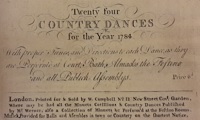
|
The contents are:
Astleys Hornpipe, The Defeat, Astley's Ride, Trip to Hatfield, Harvest Home, The Milk Maids, Lady Mordaunt, The Savages Dance, Reading Races, Bath Assembly, Miss Lewis's Fancy, The Birth Day Ball, Lady Sarah Windsors Fancy, La Jolie Petit Chanson, Trip to Galloway, Miss Parkers Fancy, Miss Phillips Allemand, Richmond Prospect, The Harpers Fancy, Lord Eglintouns Reel, Miss Sharps Delight, Harlequins Triumph, Gretna Green, The Turks Dance.
Full Title: Twenty four Country Dances for the Year 1784. With proper Tunes and Directions to each Dance as they are Performed at Court, Bath, Almacks, the Festino and all Publick Assemblys. Price 6d.
Image © THE BRITISH LIBRARY BOARD, a.9.d.(3.). ALL RIGHTS RESERVED
|
Twenty four Country Dances for the Year 1785 |
|
This information is from WorldCat.
The contents are:
The New German Spa, The Deserter, Capt Warner's fancy, or, Les trois Baron, Miss Smiths fancy, The Merry Quaker, The Bed of Roses, La Tuteur Trompe, Lady Betty Cochrans Rant, Lady Betty Boyles Reel, Miss Balfours Delight, Nottingham Heath, Haste to the Camp, The Margate Wash, Miss Norths Fancy, Carlton House, Lady Catherine Howards Fancy, Miss Lucy Campbell Fancy, The Irish Volunteers, The Circus, Trip to the Grove, Miss Douglas Reel, Wandsworth Fair, The Brothers, The Jubilee.
Full Title: Twenty four Country Dances for the Year 1785. With proper Tunes and Directions to each Dance as they are Performed at Court, Bath, Almacks, the Festino and all Publick Assemblys. Price 6d.
|
Twenty four Country Dances for the Year 1787 |
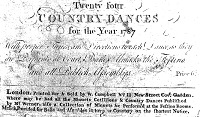
|
The contents are:
The Charming Fair, Edinburgh Assembly, Galloway House, La Belle Espagniole, A Trip to Brighton, The Village Delights, The Fife Hunt, La Gaillard, The Roundelay, The New Spa, Epping Place, Love in a Camp, The Royal Grove, Vauxhall Jubilee, The Fair Peruvian, Fontainbleau Races, Trip to Matlock, The Devonshire Nymph, Cumberland Houses, The German Allemand, The Race Horse, The Humours of Dublin, Exeter Assembly.
Full Title: Twenty four Country Dances for the Year 1787. With proper Tunes and Directions to each Dance as they are Performed at Court, Bath, Almacks, the Festino and all Publick Assemblys. Price 6d.
Image © VWML, EFDSS
|
Twenty four Country Dances for the Year 1790 |
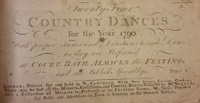
|
The contents are:
Ashleys Ryde, The Oak Stick, Lingo's Whim, Capt Macklean, L'a Belle Arsene, Dreary Dun, Duncan Grey, The Tempete, The Irish Jig, Rattle the Bottles, The Sailors Return, The Cestus, Peasants Dance, The Burlesque, Duke of Gordons Birth Day, Irish Girl, Kiss me Sweetly, Tops and Bottoms, The Naval Review, The White Cockade, Morgan Ratler, Keep it up, Mr Sellingers Second Hornpipe, Wilkinson Hornpipe.
Full Title: Twenty four Country Dances for the Year 1790. With proper Tunes and Directions to each Dance as they are Performed at Court, Bath, Almacks, the Festino and all Publick Assemblys. Price 6d.
Image © THE BRITISH LIBRARY BOARD, a.9.z.(2.). ALL RIGHTS RESERVED
|
Twenty four Fashionable Country Dances for the Year 1791 |
|
This information is from WorldCat.
The contents are:
The Gobyo, Jumping Joan, or, Loch Earn, The Waltz, Sr. Alexr. McDonald's Reel, Mony Musk, The Haunted Tower, The Charms of the Fair, Quoz, The Maria, or, Miss Murrays Fancy, The Duke of Yorks Cotillion, Glasgow Lasses, The Rose Tree, Lady Baird's Fancy, Parson in his Boots, or, The Welsh Jig, A Trip to Bath, Hallow Fair, Sr. Alexr. Don's Reel, Baltiorum, Captain Racket, The Milliner, Jenny Sutton, Money Musk, George Gabril Dance, Edinburgh Castle.
Full Title: Twenty four Fashionable Country Dances for the Year 1791. With their proper Figures, as performed at Court, Bath, Willis's, and all Public Assemblys. Price 6d.
|
Twenty four Fashionable Country Dances for the Year 1792 |
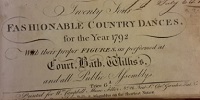
|
The contents are:
The Village Maid, The Contented Farmer, Stour Lodge, The Humours of Kildare, The Irish Washer Woman, Money in both Pockets, The Cass of Gowrie, Monmouth Assembly, Miss Napiers Reel, Lady Betty Cochran's Reel, Lewie Gordons Strathspey, New Road, Shane's Castle, The Village Fair, New Bath Crescent, Weymouth Terrace, The Laket, Mrs Fraser's Strathspay, Blue and Buff, Brans Park, The Duke of Clarences Fancy, Una's Lock, A Trip to Yarmouth, Windsor Park.
Full Title: Twenty four Fashionable Country Dances for the Year 1792. With their proper Figures, as performed at Court, Bath, Willis's, and all Public Assemblys. Price 6d.
Image © THE BRITISH LIBRARY BOARD, a.9.nn.(1.). ALL RIGHTS RESERVED
|
Twenty four Fashionable Country Dances for the Year 1793 |
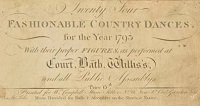
|
This information is from The-saleroom.com.
This work is almost identical to Longman & Broderip's 24 Country Dances for the Year 1791.
The contents are:
Blink Eye'd Madge, Toby, The Woods of Bargenny, The Village Delights, The Belle Duchess, Miss Whiteford's Reel, Sulky Bob, Dumfries Hause, Screech Owl, Trip to Byram, The Dons Whim, Marianne, The Picq's Gavott, Miss Ferguson's Fancy, The Fair Peruvian, La Gaillard, Banknote, Farlop Fare, Hook's Fancy, Portland Place, Miss Powell's Delight, Lambeth Bells, Miss Pultney's Fancy, Margate Assembly.
Full Title: Twenty four Fashionable Country Dances for the Year 1793. With their proper Figures, as performed at Court, Bath, Willis's, and all Public Assemblys. Price 6d.
|
Twenty four Fashionable Country Dances for the Year 1796 |
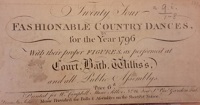
|
This work is almost identical to Longman & Broderip's 24 Country Dances for the Year 1795; it contains 26 Country Dances.
The contents are:
Dainty Davie, Dundee Lodge, Dumfries House, Wooburn Abbey, Trip to Scotland, Keep it up, The Royal Hunt, Marry Kitty, The First of June or the Sailor's Rant (a Bath Dance), The Earl Marshall's Reel, Tartan Bonnet, Ashleys Flag, The New Theatre, Lady Gores Allmande, Careless Sally, Morays Fancy, The Hardy Sailor, The New Fair, Kentish Cricketters, The Prusian Quick Step, Barham Downs, The Duke of Yorks Quick Step, Charles Street Bath, The Caledonian Hunt, Boughton Lodge, Capt Kennedys Reel.
Full Title: Twenty four Fashionable Country Dances for the Year 1796. With their proper Figures, as performed at Court, Bath, Willis's, and all Public Assemblys. Price 6d.
Image © THE BRITISH LIBRARY BOARD, a.9.i.(1.). ALL RIGHTS RESERVED
|
Twenty four Fashionable Country Dances for the Year 1798 |
|
This information is from WorldCat.
The contents are:
Go to the Devil and Shake Yourself, or Capt. Thorntons Delight, Keep the Country Bonny Lassie, The Weymouth Reel, The New Theatre, The Jocky Club, Philly Mac Cue, Old Roger of Coverly, Lady Milners Reel, Doctor Mock and I, Follow her over the Border, Up in the Air, Logie of Buchan, Capt. Trollops Fancy, Weybridge Races, The Irsh Whim, Lamberton Races, Coll: Cathcarts Reel, The New Grove, Kissing goes by Favor, New Rigg'd Ship, Hampshire Fencibles, Chapples Reel, Little Peggys Love, The Humours Kilkenny.
Full Title: Twenty four Fashionable Country Dances for the Year 1798. With their proper Figures, as performed at Court, Bath, Willis's, and all Public Assemblys. Price 6d.
|
Campbell's dance publications were amongst the best that were produced by London's music shops around the turn of the 19th Century. They were imperfect however. Two dancing masters published books about Country Dancing in the 1810s, John Cherry and Thomas Wilson, both commented on the poor quality of the typical Country Dancing publications of their day. Neither mentioned specific publishers by name, but they probably would have included Campbell's publications within that criticism. We've investigated their judgement in some of our other research papers; a paper that explores their concerns over Country Dancing music can be found here.
London's Country Dancing tune books didn't achieve genuine excellence until an important c.1812 partnership arose between Button and Whitaker (an innovative new music shop), and Thomas Wilson (a systematic and prolific reformer of the Country Dancing industry). Their story will be continued in another research paper.
|


 Figure 1. Campbell's Trade Card (possibly). Courtesy of the British Museum.
Figure 1. Campbell's Trade Card (possibly). Courtesy of the British Museum.
 Figure 2. A publication by Mr Lemaire, 1783, printed and sold by Campbell.
Figure 2. A publication by Mr Lemaire, 1783, printed and sold by Campbell.
 Figure 3. Reprint of Campbell's c.1786 1st Book
Figure 3. Reprint of Campbell's c.1786 1st Book
 Figure 4. Campbell's La Boulanger from his c.1789 4th Book
Figure 4. Campbell's La Boulanger from his c.1789 4th Book
 Figure 5. Campbell's Explanation of the Country Bumpkin from his c.1799 14th Book
Figure 5. Campbell's Explanation of the Country Bumpkin from his c.1799 14th Book
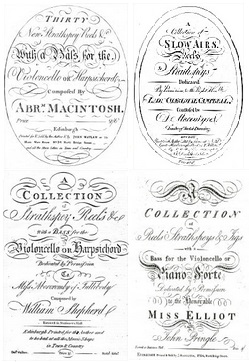 Figure 6. Example Scottish Dance Tune Collections, courtesy of the Highland Music Trust
Figure 6. Example Scottish Dance Tune Collections, courtesy of the Highland Music Trust
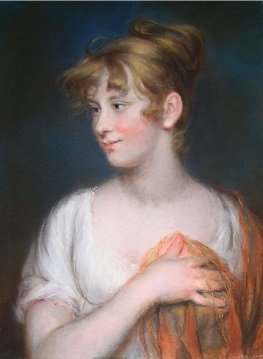 Figure 7. Miss Weippert by John Russell, courtesy of pastellists.com.
Figure 7. Miss Weippert by John Russell, courtesy of pastellists.com.
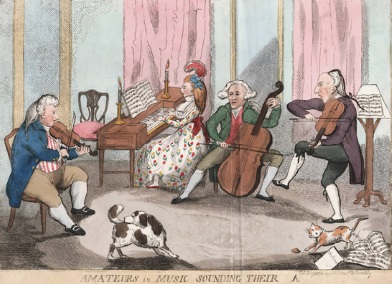 Figure 8. Amateurs in Music, 1794, courtesy of the Lewis Walpole Library
Figure 8. Amateurs in Music, 1794, courtesy of the Lewis Walpole Library